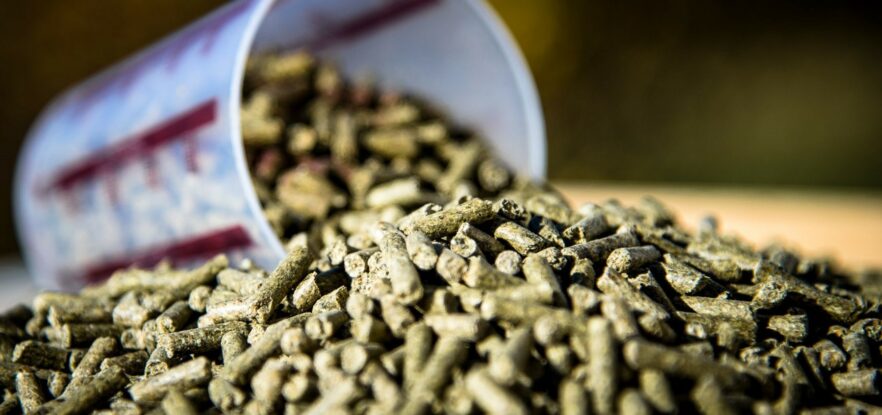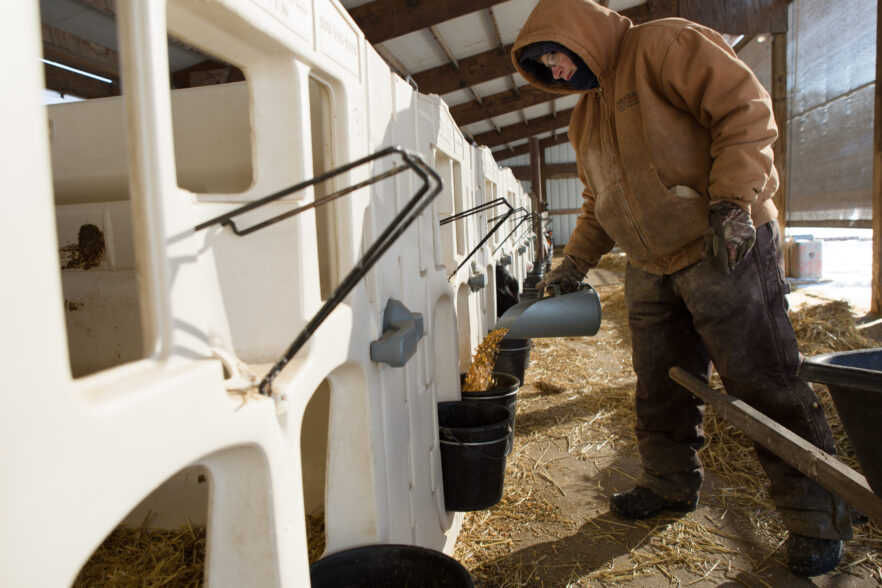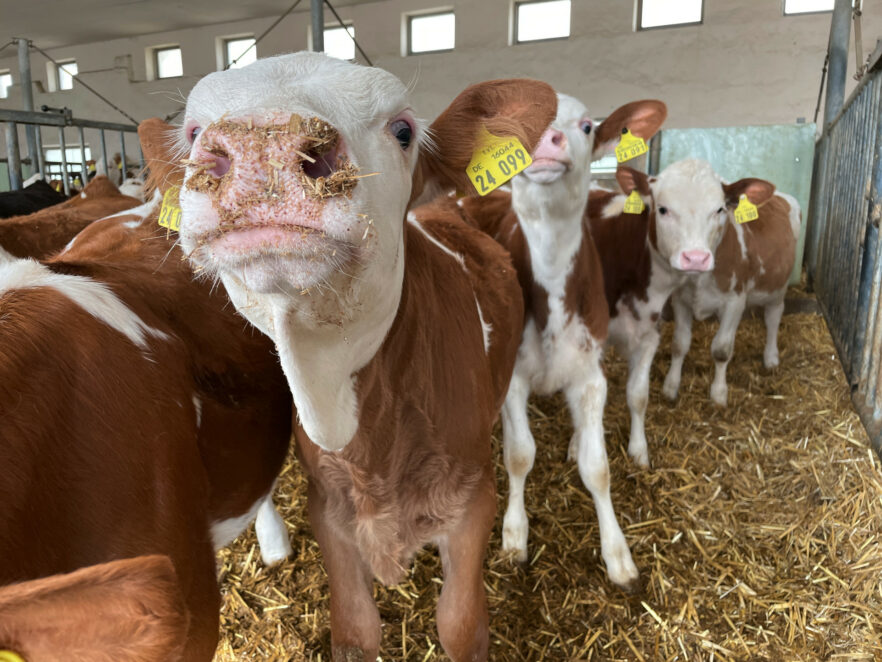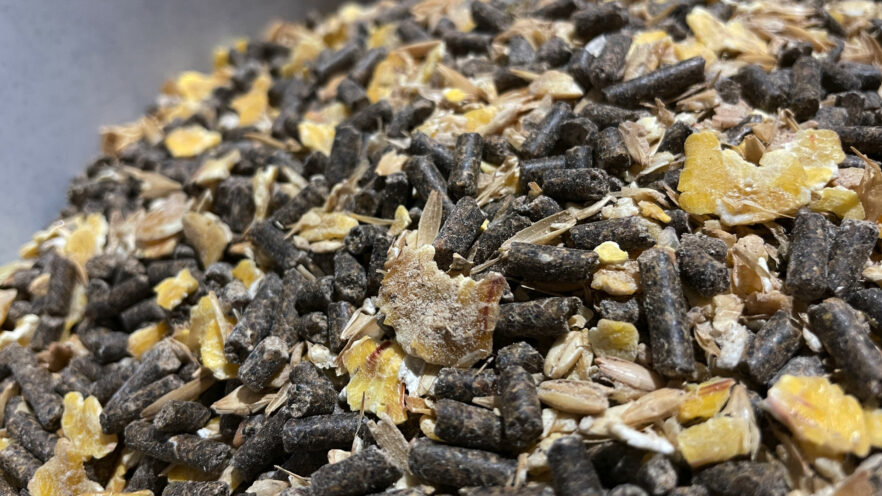The right mix makes the difference – concentrate part 2
6. Juni 2022 — General Information, Calf Feeding — #weaning #Power supply #Calf cereal #Concentrated feed #Rumen development #Dry TMR #Growth #GainsDemands placed on a good concentrate for calves
Concentrate feed for calves should contain at least 11 MJ ME/kg and approx. 18 % raw protein. Raw fibre and ash content should not exceed 10 % each. Care should be taken to ensure sufficient minerals and vitamins.
This article is about:
The 3 basic conditions for good feed
Concentrate feeds for calves must not only provide all the necessary nutrients, but must also meet three other important requirements:
- They must be easy to digest and palatable at the same time.
- They must be very tasty to stimulate high early intake.
- They must be properly hygienic, as the calves' defences are still developing.

highly digestible and easily absorbed
Calf starter feeds need to be broken down by special processing methods so that the nutrients they contain are easily digestible. Depending on the raw material, this is done by heat and/or pressure. But more about this later.
The challenge, however, is that the digestibility of the components should not lead to them over-acidifying the rumen. Instead, components should be used that break down slowly in the rumen and are thus gentle on the digestive system.
This is especially important when aiming for high concentrate consumption at a very early stage. This could be the case, for example, if you feed the calves restrictively (i.e. less than 8 l/day) and wish to wean them off milk early (10 weeks and less).

Tasty and attractive for calves
The purpose of concentrate feed is to provide the calves with sufficient energy and protein for very good growth as early as possible. To achieve this, feeds must be very appetising and encourage early intake. Ultimately, it is the calves themselves that decide when to start eating solid fodder.
Perfectly hygienic
What is easily digestible for calves is also an ideal breeding ground for rodents, bacteria and fungi. Heat treatment, e.g. pelletising, kills any bacteria that may already be present, but there are also plenty of risks during storage or in the feed trough.
It is therefore absolutely essential to prevent the feed from becoming damp. This applies to both storage and feeding in the trough or bowl. Apart from rain and high levels of humidity, the calves are responsible for making the feed in the bowl moist when they repeatedly dip their mouths into the feed, but then play with it more than eat it. So it is important not to put too much food in the bowl or trough at once. The trough should be emptied on a daily basis and leftover feed should be disposed of.

What components should make up concentrate feed?
In general, a distinction is made between energy-rich and protein-rich feeds and mineral/vitamin components.
Energy-rich components
Calves can very easily digest the starch contained in oats. The structure of the starch in the endosperm makes it very easy for the enzymes to access it. In addition, the starch is slowly broken down in the rumen and the mucous substances that the oats develop in the digestive tract protect the intestinal wall.
Since the starch contained in maize is also broken down slowly, it means that it is also very gentle on the rumen. Furthermore, calves love maize. It is particularly popular in calf cereal with whole kernels, as it takes longer to break down each individual kernel. These grains are not excreted in the faeces until calves are about 10-12 weeks old, which is why crushed or ground grains should be used for calves from this age onwards.
Wheat and barley are also good for feeding calves. They have a higher energy content, but the starch is broken down more quickly, which is why they should only be used to a limited extent.
Molasses is very attractive for calves because of the sweetness it contains. In addition, molasses binds the dust in the mixture and holds the individual components together well ("glue"), which makes molasses very popular in home-made mixtures and in cereal. However, too high a proportion can lead to diarrhoea, which is why a maximum of 5 % should be mixed into the concentrate.
Dried pulp can also contribute sugar to the feed. It is readily eaten by calves and is gentle on their rumen.
Rapeseed and soya oiladd energy to the mixture via their fat. They also bind dust. However, the amount should also be kept to a maximum of 1 % for hygienic reasons.
Protein-rich components
Soya, rapeseed and peas, as well as their processed products, are known for their high-quality amino acid composition, which can be easily digested by calves.
This also applies to linseed cake, which also produces mucous substances that protect the walls of the gastrointestinal tract. It is also very tasty for calves and they enjoy eating it.
Vitamins and minerals
Vitamins A and D are important for the growth and immune system of calves.
This applies equally to vitamin E, which also prevents oxidation and ageing processes in the cells.
Vitamin C is well known to be very healthy.
And Vitamin B in particular promotes rumen development in young calves.
It is of course equally important to provide minerals. However, the products available on the market are usually actually overdosed, so that a sufficient supply of vitamins and minerals to the calves can always be assumed once the recommended dose of commercially available products is administered.

Technical treatment of the feed
The above-mentioned components can be optimised for calf and young cattle feeding by the way they are handled during processing.
For example, starch in grain can be broken down by hydrothermal processes (steam heating) in such a way that it is easier to digest. This is also common practice with soya and other proteins. This makes the proteins easier to digest because it breaks down certain substances that inhibit protein digestion.
Conventional processes such as peeling, grinding, crushing or flaking also ensure that the components can be more easily digested. Moreover, these procedures help to prevent rumen acidosis.
Pelletising under heat and pressure also reduces bacteria and prevents the individual components from separating.
